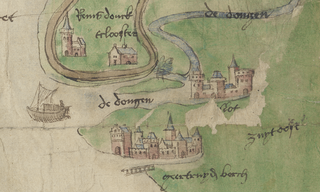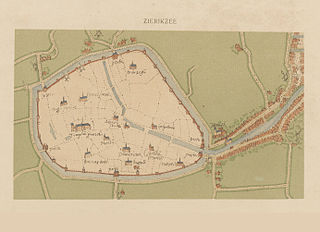
The Hook and Cod wars comprise a series of wars and battles in the County of Holland between 1350 and 1490. Most of these wars were ostensibly fought over who should hold the title of "Count of Holland", but some have argued that the underlying reason was a power struggle conducted by the bourgeois in the cities against the ruling nobility.

The Battle of Zwartewaal was a decisive naval battle during the Hook and Cod wars.

The Van Wassenaer family is the name of an old Dutch noble family. It was first mentioned in the County of Holland on 3 November 1200. They are one of the few original noble families from Holland that has survived to this day. Members of the family carry the title of count or baron.

Dirk III van Brederode was lord of Brederode.

Brederode Castle, also called the Ruins of Brederode, is located near Santpoort-Zuid. The castle was founded in the second half of the 13th century by William I van Brederode (1215–1285). William was a descendant of the lords van Teylingen, who were related to the counts of Holland. The castle formed part of the high lordship Brederode, which had been given in loan in the 13th century to the lords of Brederode by the count of Holland.

John II, Lord of Polanen was Lord of Polanen, Lord of De Lek and Lord of Breda.

John IV, Lord of Arkel was Lord of Arkel from 1326 until his death.

The Van Polanen family are a noble family that played an important role in the Netherlands during the Middle Ages. By inheriting the vast properties of the House of Polanen, the House of Nassau in 1403 became a landowner in the Netherlands for the first time.

John I, Lord of Polanen was Lord of Polanen, and Lord of De Lek.

Willem V of Horne was a medieval nobleman.

Polanen Castle was a castle located in today's Monster, South Holland in the Netherlands. The ancestral home of the Polanen family, it suffered a siege in 1351 and was demolished in 1394. It was replaced by a small manor somewhat to the south.

The Cod Alliance Treaty was a 1350 or 1351 treaty by which a number of nobles and cities allied with William V of Holland against his mother Margaret II, Countess of Hainaut and her allies. It was signed in the first phase of the Hook and Cod wars.

The Hook Alliance Treaty was signed during the first phase of the Hook and Cod wars in the County of Holland. By this treaty the Hook faction promised to support Margaret II, Countess of Hainaut against her rebellious son William of Bavaria.

The Battle of Veere was a small naval battle that took place in late May 1351 during the Hook and Cod wars.

Dirk III van Wassenaar was Heer van Wassenaar and burggraaf (burgrave) of Leiden.

Jan II van Haamstede was lord of Haamstede and Haamstede Castle.

Floris I van BorselenFlorens de Bersalia was lord of Sint-Maartensdijk and Sint-Maartensdijk Castle, the count's lieutenant in Zeeland and keeper of the seal of Holland.

Geertruidenberg Castle was a major medieval castle in Geertruidenberg, then part of County of Holland now in North-Brabant, Netherlands

The Siege of Zierikzee (1351) was a relatively unknown siege of Zierikzee during the first of the Hook and Cod wars.

Philips I, Lord of Polanen became Lord of Polanen in 1345. He later became Lord of Capelle, Nieuwerkerk, and Uyterlier. Philips was an important commander during the Hook and Cod wars.



















